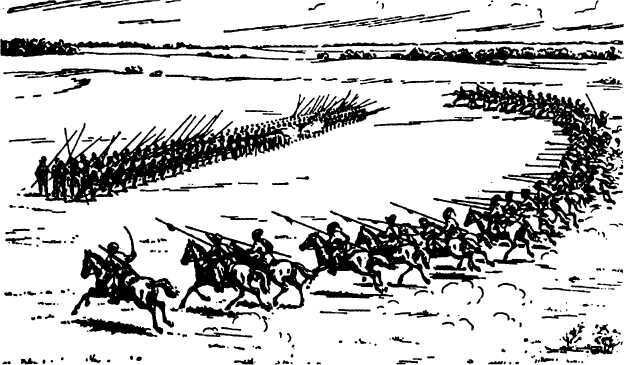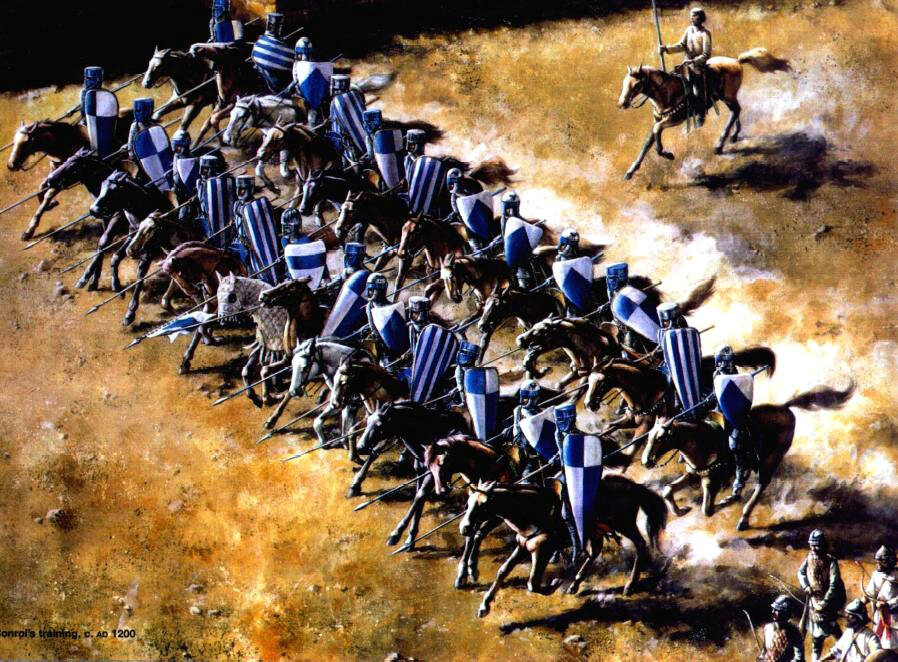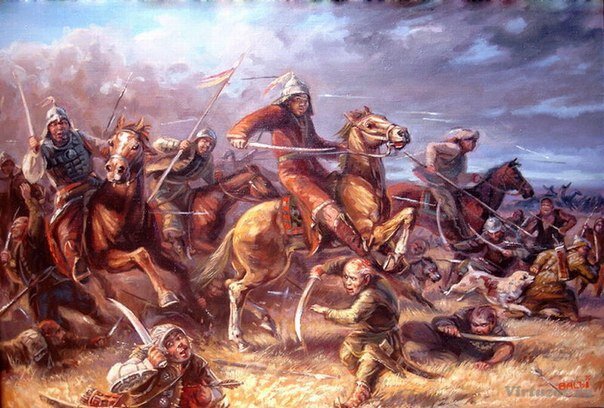Many battles with the Kipchak cavalry ended in European defeats. For the first time nomads began to defeat civilization. Why?
An unknown enemy
When midnight came, Khan Bonyak rode alone onto the field and howled wolfishly.One and then all the wolves responded.Then the khan returned to the camp and said to Igorevich.Tomorrow we will win.So the annals describe the wolf combat ritual, the wolf was the main patron of the tribe «Sary-Kipchaks», which the Russians called Polovtsy («yellow»)
The capture by the Kipchaks of vast lands from the Irtysh to the Danube became possible due to the level of military art, unprecedented among nomadic hordes. Perhaps, only Huns and Mongols possessed the best quality of martial art. Unlike the Khazars and Pechenegs, the Europeans were never able to defeat the Polovtsians, recognizing the wild nomads as an equal party in European politics. Only the all-conquering roller of Genghis Khan swept the Cumans from the arena of history.
The entire Cumans nation consisted of 12-15 nomadic hordes of 30-40,000 people. The hordes were divided into kurens, those into koshas. At the head of kosh were koshevs. The structure will be copied by Russians and passed to our Cossacks from the Golden Horde. The total number of Polovtsians with families was not more than 500 000, it is the population of one Constantinople. And in any war families and winter-houses it was necessary to protect, to leave a part of warriors. Therefore Kipchaks could send not more than 20-40 000 horsemen for a campaign. But usually they were armies of 5,000-9,000.

The strength of the Kipchaks was not in numbers, but in skill. In instant mobilization and maneuverability. Everyone sat in the saddle from the age of 3 and learned the art of mounted combat and accurate shooting. The horde moved very quickly, each warrior had 2 horses. In battle they hit with bows, darts and harnesses. But they did not shy away from close combat. They could defend themselves, for which they lined up numerous wagons in a circle and shot with heavy crossbows, unknown in Europe, but borrowed in China.
War strategy
From the horse came the strategy — swift mounted raids and withdrawal with the booty back with minimal losses. The Russian princes’ love for infantry, handed down to them from the Vikings (Varangians), who did not know cavalry, also helped the success of this. For the appearance of Russian cavalry on the battlefields we should thank the Polovtsians, who had to constantly run after them.
Rapid withdrawal with conducting of covering fight by rearguard was the favorite Polovtsian way to avoid losses and to keep the booty. They did not like to storm cities, but at the turn of the XI-XII centuries they plundered Russian fortresses in order. Big frontal battles were infrequent and concerned the campaigns of famous kagans — Bonyak, Sharukan and Tugorkan.

3 variants of application of Cumans cavalry
The tactics of action came from mobility. The Kipchaks had almost no armor, there was no infantry, and distant and maneuvering cavalry combat was the only way to achieve victory. Like the Mongols, the Kipchaks professed false retreats under the blow on the stretched opponent, attack from ambushes, massive bombardment with darts and bows Sarmatian ring, bypass maneuvers, flanking embraces. The Polovtsians also practiced night attacks (the battle on the river Alta in 1068).
Battle tactics
The tactical unit of battle was a kosh — a clan detachment with a koshev at its head and its banner. The number of the detachment fluctuated from 30 to 400. In frontal combat the Polovtsians preferred horse maneuver. At the start of the battle Cumans cavalry was built in 1-2 rows, strongly stretching along the front for flank coverage. The battle began with shelling of the enemy’s formations and quick attack of weak points with scattered lava. The main task of the Kipchaks in the battle were enemy archers and cavalry. The enemy infantry was passive and limited to the defense of archers.

cavalry attack by lava
When it was necessary to take a frontal attack of the enemy cavalry, part of the koshas quickly gathered in a dense column 3-4 rows deep, led by the elite reserve armed with lances. The rest scattered to attack from the flanks and rear.

mounted attack by column

counter cavalry lava and false retreat
Armament
Having arrived in Europe, the Kipchaks partially adopted their armament and experience from it
Armor
Most of the Kipchaks did not have any iron armor. There were quilted cotton coats and dense shirts from arrows and tangential blows. Where did the nomads get their forges from? But some part of armor and weapons got to them. Since the middle of XII century border Russian smithies begin to make steppe weapon for sale. Besides Kipchaks were rearmed by peoples of Caucasus, in particular Alans. Quality Byzantine weapon got to the Cumans nobility in the form of tribute and gifts.

Evolution of the Cumans warrior in the course of contact with the arms of the West
But all this was of a fragmentary nature, the Cumans did not understand why armor was needed in mobile combat. Some amount of lat cavalry from among the chiefs and elite guards did not affect the tactics of light combat, but took a frontal attack of the enemy cavalry in a column.
Bows
Like the horse, bows were the breadwinner and protector. The Kipchaks used the more progressive «Uigur» bows of the Siberian nomadic civilization. Unlike the old «Hunnish» bows that the Huns used to destroy Rome, they had fewer overlays and inserts, were lighter and easier to make. The length of the bows was up to one and a half meters, and the tension force up to 50 kg.

above, a Hunnic bow. below, a Uighur bow.
During the transition from peace to war, the bow did not change, only the arrowheads changed. Change from the target — whether it was a hare on the hunt or a Russian druzhinnik in a ring gear. As a rule, the quiver was carried on the left side in a slanted position. Arrows in quivers were carried plumage downwards, tips upwards.
Sabers
The Kipchak’s weapon of close combat was the saber. It is connected again with the tactics of maneuver battle, where the shelling is quickly replaced by mounted chopping with the maximum number of blows and rebounding into the shelling again.
The Kipchaks came to Europe with primitive Trans-Ural sabers 0,9 meters long. And then having borrowed samples of Caucasus sharply strengthened their curvature and increased their length. They met the Mongols with sabers already more than a meter long with Arabic and Armenian script, having accumulated by that time a great experience in the Middle East. The scabbards were almost all red.
evolution of the Cuman blade

Cuman saber of the XI century

Cuman sabre of the XIII century.
Interestingly, the Russians adopted melee weapons from the nomads. Russian swords were gradually supplanted by sabers in the cohorts of Russian princes.
For all their tactics, the Cumans hordes were weak during the wintering period. In summer any movement in steppe will not hide from a sharp Cumans’ sight. Summer is the time of Cumans’ feats of arms and booty. But in winter. In winter horses were skinny, and clans were in temporary winter-houses in a dismounted state. On frozen rivers went Russian druzhiny to well-known Polovtsian camps, smashing them and driving them deep into the steppe. Then Kipchaks and Russians became allies, having transferred to each other military art.
Warning
The Kipchaks for Europe became the first nomadic people of a new level — a tactically competent opponent, in the basis of success which were new techniques of close combat and masterful use of the bow and horse. Earlier for Europeans nomads were a herd, chaotically fighting without much thought. The Huns and Goths that brought down Rome were unknown to them.
The Kipchaks were a warning. Writhing in labor pains, the East nurtured an absolute enemy. Western civilization has not drawn conclusions. And soon it will strike with all its might.
